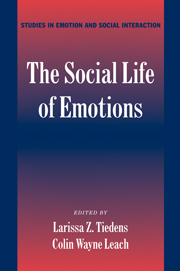Book contents
- Frontmatter
- Contents
- Acknowledgements
- List of Contributors
- The Social Life of Emotions
- Introduction: A World of Emotion
- PART I THE INTERPERSONAL CONTEXT
- 1 Empathy
- 2 Envy and Its Transmutations
- 3 The Bond Threat Sequence
- 4 Emotion as Adaptive Interpersonal Communication
- 5 Does Expressing Emotion Promote Well-Being? It Depends on Relationship Context
- PART II THE INTRAGROUP CONTEXT
- PART III THE INTERGROUP CONTEXT
- Index
- References
4 - Emotion as Adaptive Interpersonal Communication
The Case of Embarrassment
Published online by Cambridge University Press: 01 April 2011
- Frontmatter
- Contents
- Acknowledgements
- List of Contributors
- The Social Life of Emotions
- Introduction: A World of Emotion
- PART I THE INTERPERSONAL CONTEXT
- 1 Empathy
- 2 Envy and Its Transmutations
- 3 The Bond Threat Sequence
- 4 Emotion as Adaptive Interpersonal Communication
- 5 Does Expressing Emotion Promote Well-Being? It Depends on Relationship Context
- PART II THE INTRAGROUP CONTEXT
- PART III THE INTERGROUP CONTEXT
- Index
- References
Summary
The last time I was embarrassed, events unfolded in a familiar pattern. I was in the presence of others when I discovered that I had committed a small gaffe of which they were aware; coincident with my realization of my mistake came aversive arousal and a warm face, a sheepish grin, and an averted gaze. I was mildly mortified and, genuinely regretful, I apologized. In response, my audience offered some mild teasing that seemed playful instead of malicious, and I was evidently forgiven: Our interaction then continued as if my blunder had not occurred, and my miscue was not mentioned again.
This was just a single, potentially idiosyncratic episode of embarrassment, but my guess is that you recognize that pattern of events. It's prototypical. All of its elements - the public misbehavior; the unbidden, involuntary wash of chagrin and abashment; the particular sequence of nonverbal behavior; the resulting helpful, conciliatory actions; and the tolerant, lenient responses from others - characterize embarrassment among adults all over the world (Miller, 1996).
Further, just as in my example - and given that one has transgressed in some manner - most embarrassments have a happy ending. Embarrassed emotion is certainly unpleasant; it is a blend of fretful mortification and chagrin that is discomforting and sometimes humiliating. Nevertheless, among adults, embarrassment usually elicits kinder reactions from others than those that would have been forthcoming had one's embarrassment not occurred (Miller, 1996).
- Type
- Chapter
- Information
- The Social Life of Emotions , pp. 87 - 104Publisher: Cambridge University PressPrint publication year: 2004
References
- 10
- Cited by



